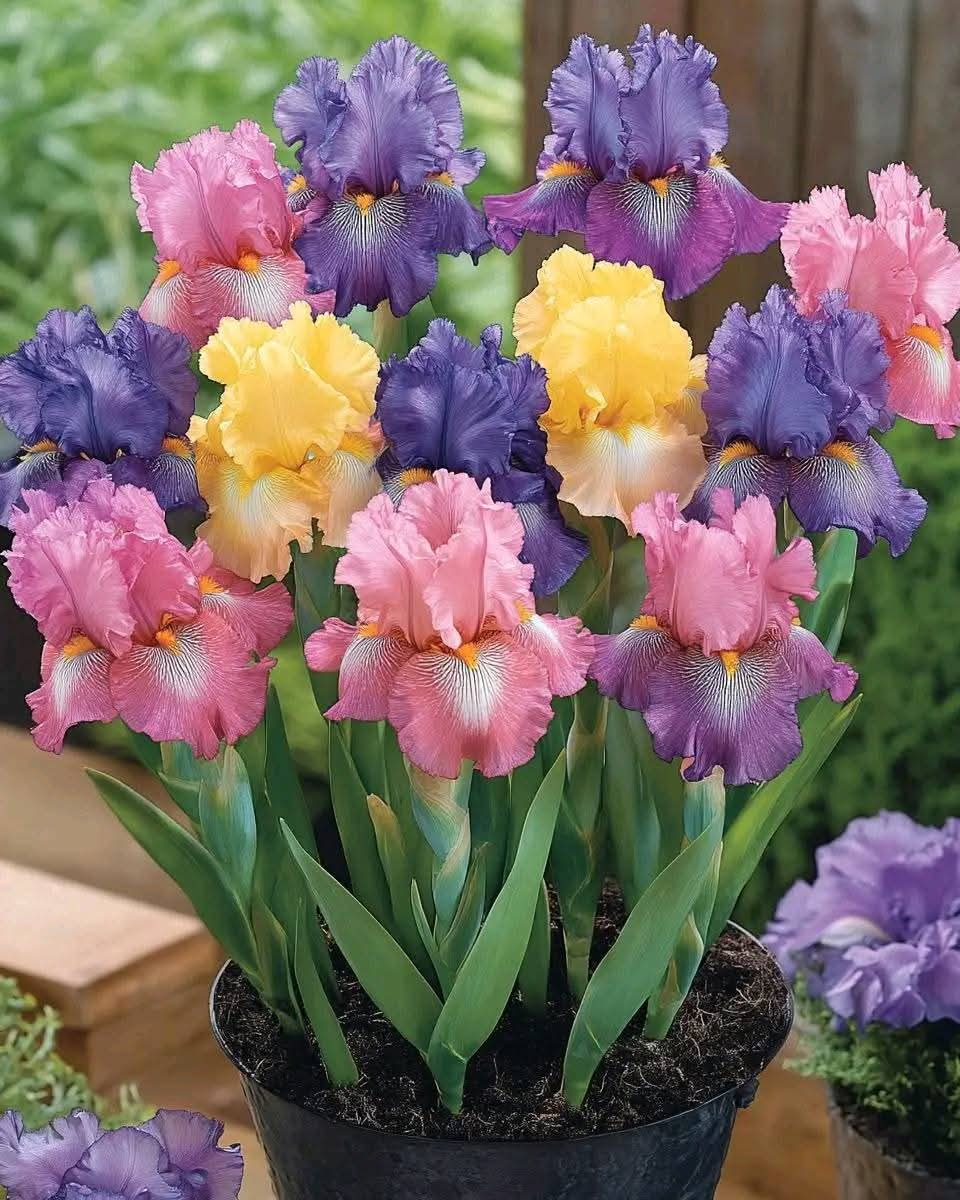If you’re looking for a bold, eye-catching flower that adds a touch of elegance to your garden, look no further than the Rainbow Ruffles Iris (Iris germanica). This striking bearded iris features ruffled petals in a beautiful blend of pink, purple, and yellow, creating a mesmerizing effect in garden beds and floral arrangements. With its unique coloration, hardy nature, and easy maintenance, it’s a must-have for gardeners of all skill levels.
Why Choose Rainbow Ruffles Iris?
- Spectacular Color Display
The multi-toned petals of this iris make it stand out in any garden. The ruffled texture adds a soft, romantic touch, making it a showstopper in spring and early summer.
- Low-Maintenance and Hardy
Rainbow Ruffles Iris is a hardy perennial that requires minimal care once established. It can withstand varied climates, drought conditions, and even poor soils.
- Attracts Pollinators
This iris is a pollinator favorite, attracting butterflies and bees while deterring deer and rabbits.
- Perfect for Cut Flowers
With its long, sturdy stems and vibrant petals, the Rainbow Ruffles Iris is an excellent choice for floral arrangements.
How to Grow and Care for Rainbow Ruffles Iris
- Sunlight Requirements
Full sun (at least 6-8 hours per day) is essential for healthy blooms.
In hotter climates, partial afternoon shade is beneficial.
- Soil Needs
Prefers well-draining, fertile soil.
Sandy or loamy soils work best, but it can tolerate average garden soil as long as it’s not overly compacted.
- Watering Schedule
Water moderately after planting, allowing the soil to dry slightly between waterings.
Once established, Rainbow Ruffles Iris is drought-tolerant, requiring only occasional deep watering during dry spells.
- Ideal Temperature & Climate
Thrives in temperate climates, withstanding cool winters and warm summers.
Can tolerate mild frost, but in extremely cold regions, apply a layer of mulch in winter to protect the rhizomes.
- Fertilizing for Best Growth
Use a balanced fertilizer (10-10-10) in early spring to encourage growth and flowering.
Avoid high-nitrogen fertilizers, as they promote leafy growth instead of blooms.
Planting & Propagation Tips
How to Plant Rainbow Ruffles Iris
Choose the Right Spot: Select an area with good drainage and full sun.
Prepare the Soil: Loosen the soil and mix in organic compost for added nutrients.
Planting Depth: Place the rhizome just below the surface, with the top slightly exposed to prevent rot.
Spacing: Keep 12-18 inches between plants to allow for proper air circulation.
Water Gently: Water thoroughly after planting and reduce watering as it establishes.
Dividing & Propagation
Divide the rhizomes every 3-4 years to prevent overcrowding and encourage better blooming.
Best time to divide is late summer to early fall after flowering has finished.
Common Problems & Solutions
- Why Isn’t My Iris Blooming?
Cause: Lack of sunlight, over-fertilization, or overcrowding.
Fix: Ensure it gets full sun, avoid excessive nitrogen, and divide the rhizomes if they are too crowded.
- Yellowing Leaves?
Cause: Overwatering or poor drainage.
Fix: Allow the soil to dry between waterings and ensure the rhizomes are not buried too deep.
- Preventing Pests & Diseases
Keep the area weed-free to avoid iris borers and fungal diseases.
Remove spent flowers and prune dead leaves to improve airflow.
Use a mild fungicide if leaf spot or rot appears.
Landscaping Ideas
Garden Borders: Plant Rainbow Ruffles Iris along walkways or fences for a vibrant display.
Mixed Flower Beds: Combine with roses, peonies, or daylilies for a layered look.
Container Gardening: Grow in large decorative pots for a portable color boost.
Final Thoughts
The Rainbow Ruffles Iris is a stunning, low-maintenance flower that adds texture, color, and elegance to any garden. Whether you’re a beginner or an experienced gardener, this iris will reward you with spectacular blooms year after year.
Are you growing Rainbow Ruffles Iris in your garden? Share your experience and tips in the comments!
More Articles You Might Like
-
Texas Toast Sloppy Joes: The Crunchy, Cheesy Upgrade You Didn’t Know You Needed
There’s something timeless about sloppy joes. For generations, this saucy, savory, and slightly sweet ground beef sandwich has been a go-to comfort food in American kitchens. It’s quick, filling, and family-friendly—perfect for busy weeknights. But what if we told you there’s a way to take this classic dish up a notch? Enter the Texas Toast…
-
Classic Pig Pickin’ Cake
When it comes to Southern desserts, few sweets shine as brightly as the Classic Pig Pickin’ Cake. This nostalgic cake, sometimes called a “Mandarin Orange Cake,” has roots deep in Southern tradition. It gets its playful name from its frequent appearance at pig pickin’s—Southern-style barbecue gatherings where communities come together to enjoy slow-cooked pork, sides,…
-
Lemon Garlic Butter Chicken with Creamy Parmesan Pasta
There’s something irresistible about the combination of tender, golden-browned chicken paired with a creamy pasta coated in Parmesan cheese. Add the brightness of lemon, the depth of garlic, and the richness of butter, and you have a recipe that feels indulgent yet approachable enough for a weeknight dinner. Lemon Garlic Butter Chicken with Creamy Parmesan…



